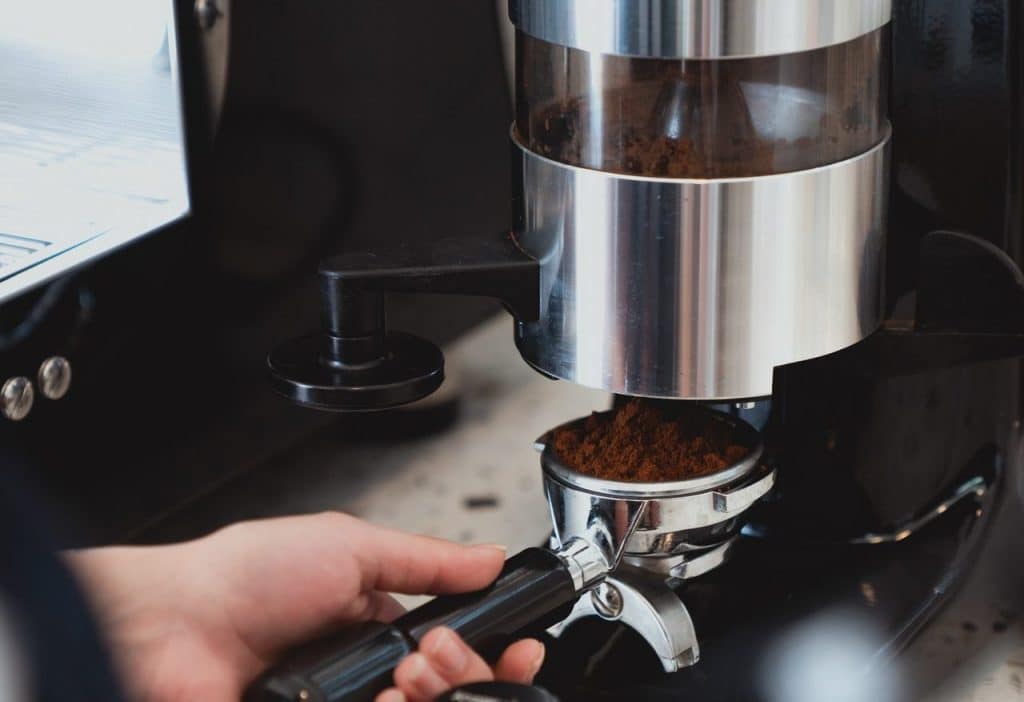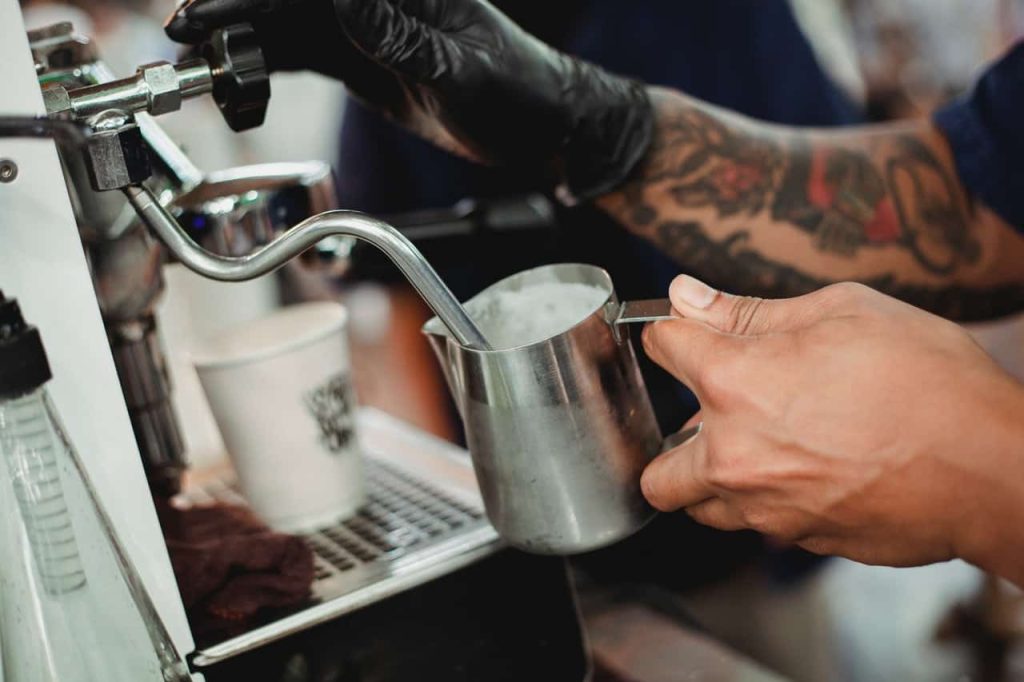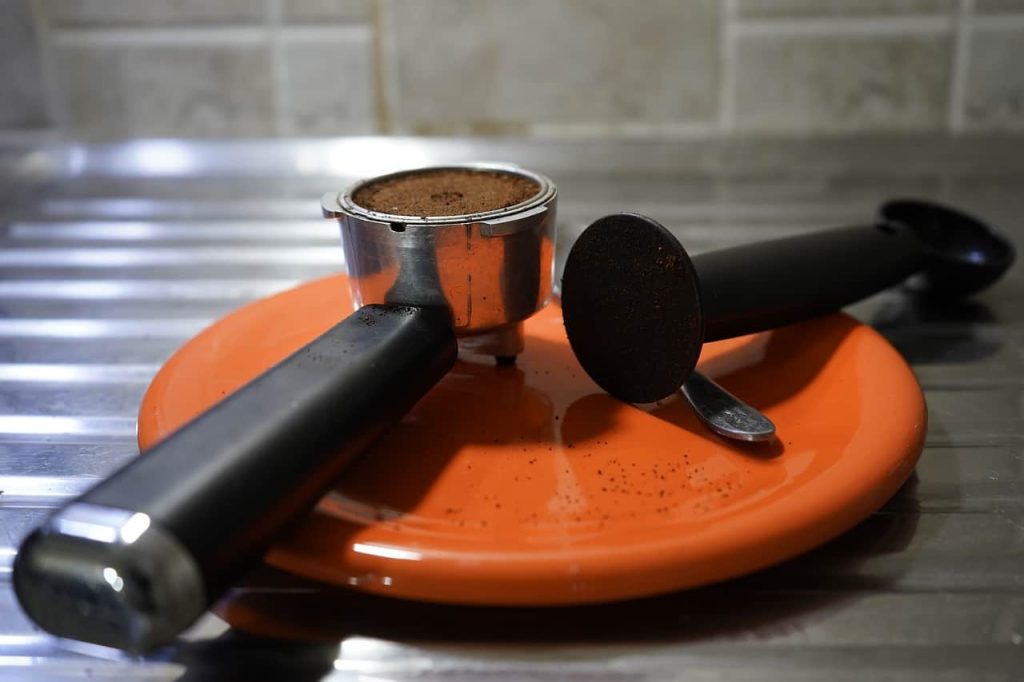How to Make a Latte with an Espresso Machine

So many things have been said about a latte, but what it’s most famous for is its sweetness and versatility. You have probably ordered it more times than you can count, and if you think the drink is too sophisticated to make, you’re wrong. Today, I’ll show you how to make a latte with an espresso machine.
It’s a simple process requiring no more than two ingredients and tools. My guess is you are new to this process or eager to learn how to go about it. Well, you have come to the right place.
Don’t let the simplicity of the process trick you into thinking you could do this on your own. A simple avoidable error could cost you the chance to experience America’s most popular coffee drink.
Join me as I take you through the right steps in making a creamy, delicious cup of latte.
What You Need
- Coffee beans
- A burr grinder
- Milk, or half-and-half, if you want to make a breve latte
- An espresso machine
- A cup or latte glass
- Toppings and syrups (optional)
How to Make a Latte with an Espresso Machine: The Steps
Step 1. Properly Grind the Coffee Beans

You must get this right. In every latte, coffee is the key ingredient, so if it’s badly prepared, your beverage will be ruined. I’m assuming you already know how to grind coffee beans for espresso.
For the uninitiated, it’s simple. Use the best coffee beans for espresso and make sure your grind is fine. I recommend you use a solid burr grinder like Baratza Encore for that. Blenders won’t do the trick, and neither will pestle and mortar.
You could also use pre-ground coffee, dark or medium roasted, but not the store-bought type. I strongly suggest you buy from a specialty coffee shop where beans are freshly roasted.
Step 2. Steam and Froth the Milk
Your lattes will need frothed milk with microfoam bubbles and minimal foam. Nothing makes this better than the steam wand on your espresso machine. As a rookie, you may find this tool a little bit difficult to use at first, but you’ll most definitely get the hang of it after a few rounds.
But first things first. For every ounce of espresso, you are going to need about 6 ounces of milk (more about milk choices later). Keep the espresso-milk ratio in mind (1:4) if you want to brew more cups of latte. Ideally, milk should make up around two-thirds of a latte cup.
Pour the milk you have chosen into a frothing pitcher. Make it 1/3 full so that there’s enough space left for the milk to expand. Thereafter, use the wand to steam it.

Submerge the entire wand to steam the milk, but only dip it about half an inch past the milk’s surface to froth the liquid. This not only ensures your drink becomes hot but also leads to the formation of froth.
While doing this, keep the temperature at 150°F because anything higher than that will ruin the natural sweetness and flavor of your milk.
Once the milk doubles in volume, move the steam wand further down to distribute the froth and ensure even distribution of heat. Turn off the steam tap, then leave the milk to cool down so that the foam rises up further. You will realize that it’s easy to layer the latte when the milk is in this state.
Step 3. Pull Your Espresso
I believe this is a walkover. A single shot will need about 6 to 8 grams of finely ground coffee beans. Increase the size twofold for a double shot.
You can make espresso in many ways. Here’s how to do it using the espresso machine.

Place the grounds in the portafilter. Make sure they are evenly distributed. Remember to tamp down the grounds as well.
Lock the portafilter into your espresso machine and pull your single or double shot. This should take roughly 30 seconds.
Wondering how a perfect shot looks and tastes? Here’s how to tell:
- Caramel colored crema layer on top
- Not too dark or light in color
- Doesn’t taste too bitter or acidic

Step 4. Pour the Frothed Milk Into Your Espresso
This is the part you want to be gentle, creative, and accurate. Remember the espresso to milk ratio I mentioned earlier? This is where you apply it. The 1:4 ratio translates to about 8 ounces of milk for every double shot of espresso.

With that out of the way, let’s talk about the pouring.
Expert baristas recommend that you begin pouring with your frothing pitcher raised from a high position, about one or two inches above the cup. Gently work your way down while making sure no foam gets into your cup until you are 1/4 in. Steepen the jug’s angle as you come closer to the cup.
Be careful not to spill your milk or espresso as this could alter the ratio and deny you the chance to enjoy what would have been a delicious, creamy cup of latte.
So that’s it. That’s how to make a latte using an espresso machine.
Elements of a Good Latte
Lattes are majorly a combination of two things, and a great cup normally has the best of both worlds — well-steamed milk and properly brewed shots of espresso.
Perfect espresso has a thin layer of reddish-brown crema, an intense full-bodied aroma, and is full of flavor. Well steamed milk, on the other hand, is silky and smooth with microfoam bubbles and not big air bubbles. This is the combination that yields a creamy delicious beverage with sweet subtle coffee flavors.
Should you find yourself with bubbles larger than your preferred size, break them down further by trying out any of these tricks:
- Bang the frothing pitcher onto the working surface
- Stir the milk
- Gently swirl the milk in your frothing pitcher
Adding Syrup or Powder to Your Latte
Flavored lattes! In the United States, they are a favorite for many coffee lovers, majorly because they treat our unique taste buds. Not many of us know that you can prepare a perfect cup of flavored latte at home and even top it off with whipped cream among other things.
Popular flavor options in the market today include:
- Vanilla
- Peppermint
- Irish crème
- Caramel
- Cinnamon
- Almond
- Hazelnut
- Toffee
- Buttered rum
- Orange
- Raspberry
Don’t want to buy? No worries, you can prepare yours at home. It’s easy. Just look for a trusted recipe online and follow it to the letter. That said, regardless of the flavor syrup or powder you choose, only add it after your coffee and before the steamed milk.
The amount you choose to add is subjective. Be guided by your taste or that of whoever you are preparing the drink for.
Frequently Asked Questions
What Type of Milk is Best for Lattes?
Frothing is a fundamental stage of the latte-making process, and it all depends on the milk you use. Your espresso machine uses the wand to blow steam (hot air) through the milk.
Nonfat/skim milk makes the best latte foam, but unfortunately, it lacks the creamier taste you would get from whole milk. Now, unless you have barista-level skills, I wouldn’t recommend you use whole milk because it doesn’t yield the desired foam that easily.
So what milk is best for lattes? Go for partially skimmed milk so that you can experience the best of both worlds — lots of froth and a creamier taste.
Can You Make a Latte With a Coffee Machine?
Espresso machines brew the best latte and are easier to use. But you could still use other brewing machines such as Aeropress, French press, or Moka pot to make a latte. The trick is to make your coffee as bold, strong, and concentrated as espresso.
Why Does My Milk Not Froth While Preparing a Latte?
Your milk may not be frothing because there’s condensed water or dirt at the tip of the espresso machine’s steam wand. Check the tip of the steam wand for condensed water. If there’s any, purge it out.
Other situations that could lead to milk not frothing properly or at all include:
- Placing the tip of the steam wand too near or way below the milk’s surface
- Failing to swirl the pitcher properly
- Using the wrong type of milk
- Heating the milk beyond the recommended temperature (150°F)
Last Thought about Lattes
Count yourself well-armed and prepared to brew an exceptional cup of latte. It’s not rocket science as you may have imagined. This simple guide on how to use an espresso machine to make a latte pretty much sums everything up.
Additional tricks such as how to make latte art or even how to make a latte without an espresso machine will be easier to master once you have perfected this process.
You do not need any special tools or skills to go about this. Your espresso machine and burr grinder are enough. Just present yourself with the required ingredients for this little coffee-making adventure, and you will be a happy camper at the end of it, having learned the magic and science behind America’s most popular coffee drink.
Owen is a writer and editor at Caffe Streets who considers himself a coffee fanatic. He spends his time researching and testing different coffee beans and brewing methods and sharing what he learns with others.






